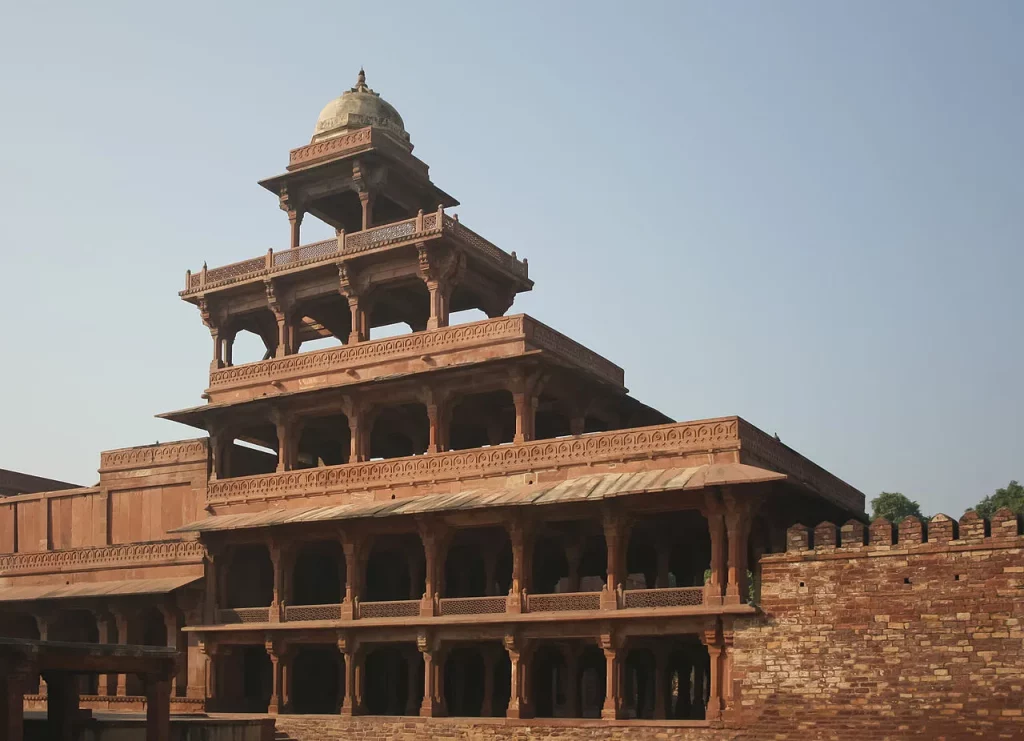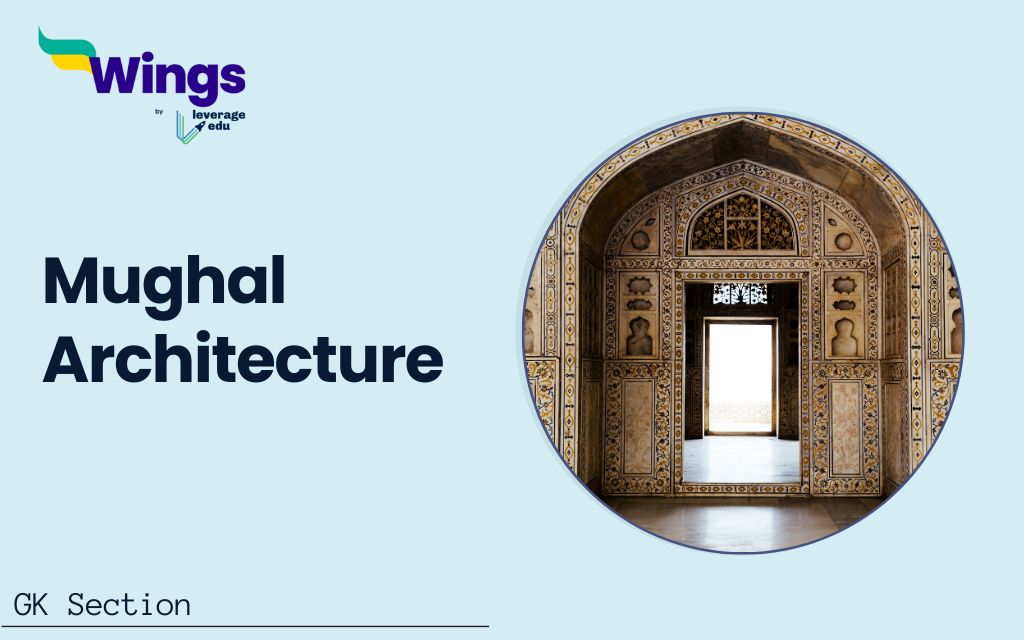Mughal architecture is the Indo-Islamic architectural style built by the Mughal emperor. When the Mughal empire extended across the Indian subcontinent in the 16th, 17th, and 18th centuries, these styles of architecture grew significantly. Modern examples of Mughal architecture can be seen in Afghanistan, Bangladesh, India, and Pakistan. This article will cover the Mughal architecture that represents the blend of Indian and Islamic structures.You can prepare for the UPSC Civil Service Exam Indian art and culture portion by understanding the features of Mughal Architecture in detail.
Contents
What is Mughal Architecture?
Mughal architecture is a distinct style that emerged in the Indian subcontinent during Mughal rule. It lasted from the early 16th century until the mid-18th century. This style is well known for its magnificent decoration, detailed carving, and harmonious blend of Persian, Indian, and regional influences.

Also Read: Mughal Empire: Origin, Rise, Administration, Decline
Key Features of Mughal Architecture
The Mughal architecture is distinguished by the essential features listed below.
- Persian Influence: Mughal architecture was highly influenced by the Persian style, particularly the Timurid style. This style is reflected in the domes, slender minarets, courtyards, and sculptures. The Mughal emperors had roots in Persian culture, which deeply influenced their architectural styles.
- Indian Elements: Apart from Persian elements, Mughal architecture featured Indian style. This is especially noticeable in the flower patterns and geometric designs. The emperors hired local artists, resulting in a combination of styles that gave Mughal architecture its distinct identity.
- Symmetry: It is one of the characteristic elements of Mughal architecture. Buildings and gardens were planned using geometric principles, with an emphasis on grids and alignment. The balanced proportions and harmonic compositions convey a sense of order and beauty to these architectures.
- Gardens & Landscaping: The Mughals were garden enthusiasts. The gardens at that time, also known as “Charbagh,” were designed in the Persian style. These gardens symbolise both paradise and the practicality of Mughal palaces and tombs.
- Use of Red sandstone and white marble: Red sandstone and white marble are used widely in Mughal construction. Red sandstone was commonly used for fortification and huge buildings, while white marble was used only for more delicate and royal structures like tombs and mosques. The variation in materials utilised in the development of Mughal art and architecture gave it its particular style.
- Decorative Arts: Mughal architecture is known for its decorative elements, arrangement, and intricate construction. During the Mughal period, semi-precious stones, floral, and geometrical patterns became increasingly popular.
Also Read: Indo-Islamic Architecture
Major Phases of Mughal Architecture
Different Mughal rulers highlighted different architectural styles that contributed to the Mughal architectural style.
Babur and Humayun
Babur and Humayun built modest structures during the early period of Mughal architecture. Humayun’s Tomb is among the earliest examples of that. The Humayun Tomb was designed by Persian architect Mirak Mirza Ghiyas and includes Persian and Indian themes.
Akbar
- The rule of Akbar saw considerable development in art and architecture, with a focus on innovation and experimentation. He commissioned various structures, notably the Agra Fort and the city of Fatehpur Sikri.
- The Agra Fort, built of red sandstone, is a vast structure with stunning gates, palaces, and mosques.
- Fatehpur Sikri is an architectural masterpiece that combines Islamic, Hindu, and Jain influences.
Jahangir
Jahangir followed the architectural legacy, emphasising delicacy and grace. He is known for his liking for gardens and smaller-scale buildings over huge forts. The Tomb of Itimad-ud-Daulah in Agra, sometimes known as the “Baby Taj,” is the most prominent example of Jangir’s architectural style. This tomb has white marble and pietra dura inlay work.
Shah Jahan
Shah Jahan’s reign is referred to as the golden phase of Mughal architecture. He built some of the most renowned and majestic structures of the Mughal Empire. The Taj Mahal is a prime example of Shah Jahan’s architecture, having been built as a tomb for his wife Mumtaz Mahal. It represents the peak of Mughal architecture. This white marble masterpiece highlighted the world’s most iconic buildings.
Other prominent constructions built during his rule include the Red Fort in Delhi and the Jama Masjid in Delhi. The architecture of Shah Jahan’s reign is characterised by his love for white marble, rich architectural decorations, and a higher level of aesthetic enhancement.
Aurangzeb and Later Mughal Emperor
Aurangzeb’s rule saw a shift in architectural style, with a focus on simplicity and conservative religious beliefs. There were fewer magnificent buildings built under his reign. He built some significant structures, including Bibi Ka Maqbara in Aurangabad.
The later Mughal period saw a fall in architectural creativity as the empire weakened with time. Even after the demise of the Mughal empire, its influence and stylistic features lasted in later developments.
Also Read: Historical Facts About Harappan Civilization
Legacy and Influence of Mughal Architecture
Mughal architecture has left a legacy that goes beyond the Mughal Empire.It is characterised by grandeur, symmetry, and beautiful decoration that reflects their cultural and creative achievements.
- British colonial architecture in India adopted the Mughal artistic style into their structures, as seen in the Victoria Memorial in Kolkata and the Rashtrapati Bhavan in New Delhi.
- Aside from that, the Mughal architectural style and aesthetics have influenced many public and private buildings in modern India and Pakistan.
- Many architectural structures and monuments of that period are classified as UNESCO World Heritage Sites. These sites attract millions of visitors from all around the world.
- The Taj Mahal, Humayun’s Tomb, Agra Fort, and Fatehpur Sikri are among the most popular tourist attractions that showcase Mughal architecture.
- Conservative efforts are made to preserve these cultural gems for future generations, ensuring that the Mughal legacy is still valued.
Related Posts
| Learn South Indian Temples With Names | Sarnath Lion Capital & Great Stupa of Sanchi |
| Indo-Islamic Architecture: Types, Categories | Delhi Sultanate Architecture: Features |
FAQs
Mughal architecture is a distinct style that emerged in the Indian subcontinent during Mughal rule. It lasted from the early 16th century until the mid-18th century. This style is well known for its magnificent decoration, detailed carving, and harmonious blend of Persian, Indian, and regional influences. The Mughals made a lasting mark on architecture, which continues to be admired for its beauty and creativity.
Some of the best examples of Mughal architecture are the Red Fort, Humayun Tomb, Fatehpur Sikri, Agra Fort, Taj Mahal and Tomb of Itimad-ud-Daulah.
The Mughal architecture is characterised by large halls, the use of red sandstones and white marble, a blend of Persian and Indian elements, and symmetry which gives a harmonious and balanced appearance to these architectures.
This was all about the “Mughal Architecture”. For more such informative blogs, check out our UPSCExams Section and Study Material Section, or you can learn more about us by visiting our Indian exams page.
 One app for all your study abroad needs
One app for all your study abroad needs














